Answered step by step
Verified Expert Solution
Question
1 Approved Answer
When the first Starbucks store opened in Seattle's historic Pike Place Market in 1971, it meant to be a different kind of company that
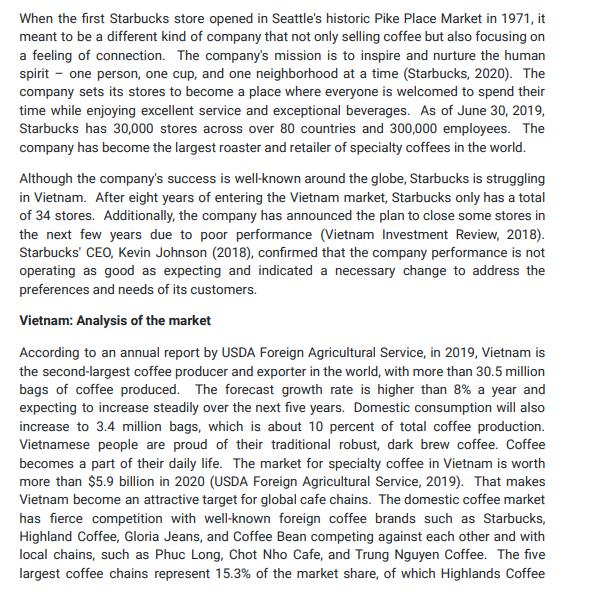
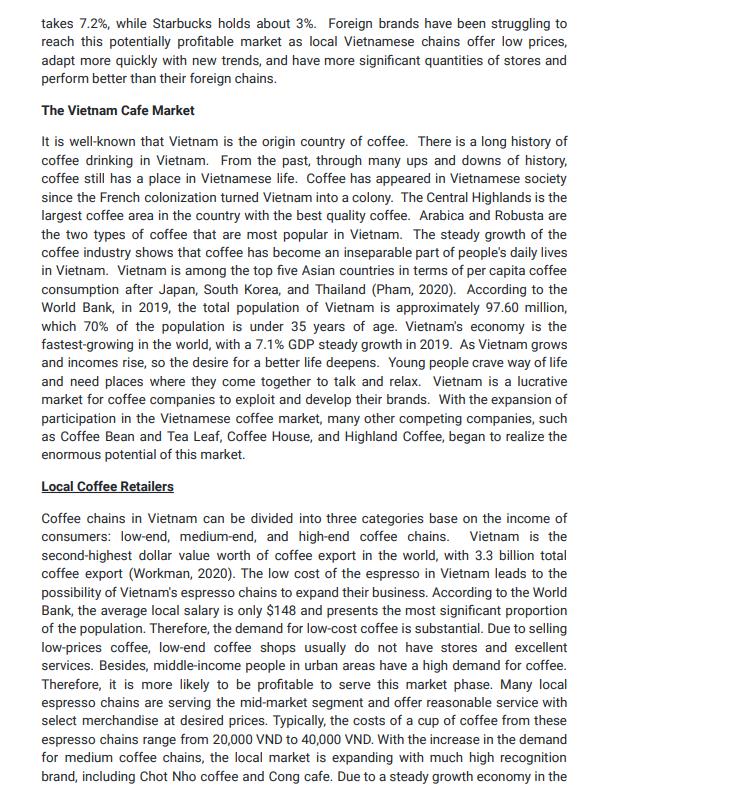
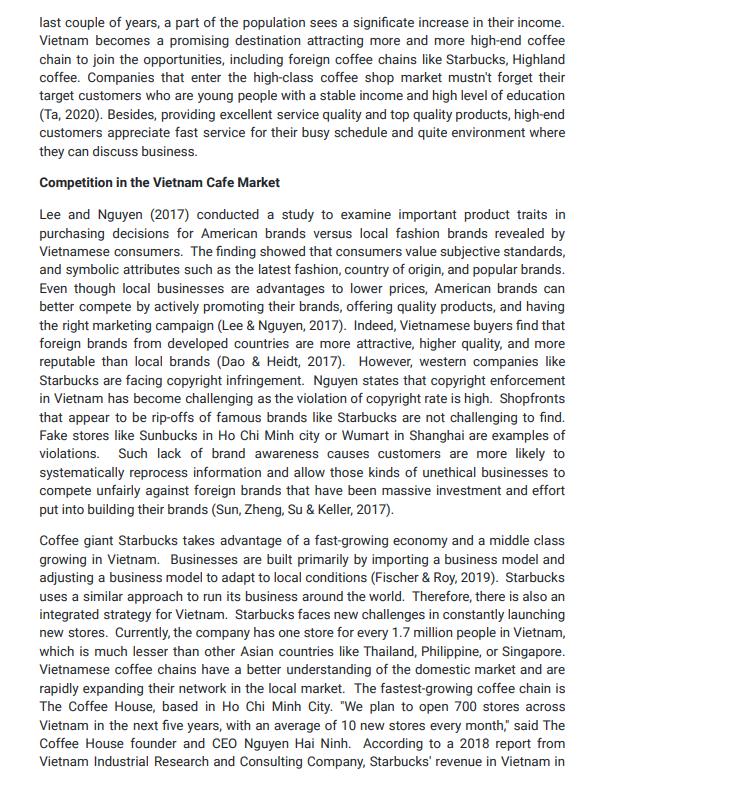
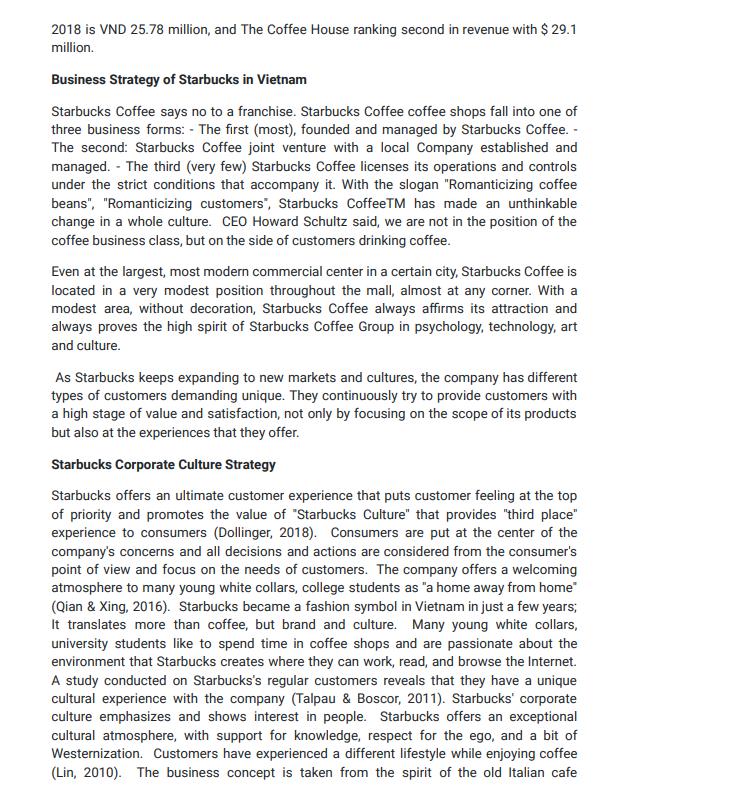
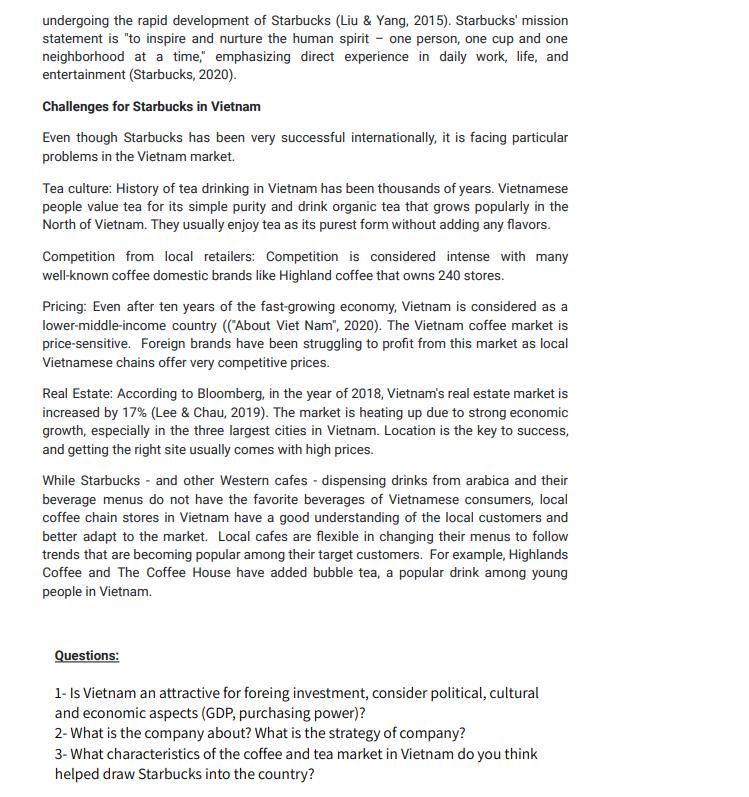
When the first Starbucks store opened in Seattle's historic Pike Place Market in 1971, it meant to be a different kind of company that not only selling coffee but also focusing on a feeling of connection. The company's mission is to inspire and nurture the human spirit - one person, one cup, and one neighborhood at a time (Starbucks, 2020). The company sets its stores to become a place where everyone is welcomed to spend their time while enjoying excellent service and exceptional beverages. As of June 30, 2019, Starbucks has 30,000 stores across over 80 countries and 300,000 employees. The company has become the largest roaster and retailer of specialty coffees in the world. Although the company's success is well-known around the globe, Starbucks is struggling in Vietnam. After eight years of entering the Vietnam market, Starbucks only has a total of 34 stores. Additionally, the company has announced the plan to close some stores in the next few years due to poor performance (Vietnam Investment Review, 2018). Starbucks' CEO, Kevin Johnson (2018), confirmed that the company performance is not operating as good as expecting and indicated a necessary change to address the preferences and needs of its customers. Vietnam: Analysis of the market According to an annual report by USDA Foreign Agricultural Service, in 2019, Vietnam is the second-largest coffee producer and exporter in the world, with more than 30.5 million bags of coffee produced. The forecast growth rate is higher than 8% a year and expecting to increase steadily over the next five years. Domestic consumption will also increase to 3.4 million bags, which is about 10 percent of total coffee production. Vietnamese people are proud of their traditional robust, dark brew coffee. Coffee becomes a part of their daily life. The market for specialty coffee in Vietnam is worth more than $5.9 billion in 2020 (USDA Foreign Agricultural Service, 2019). That makes Vietnam become an attractive target for global cafe chains. The domestic coffee market has fierce competition with well-known foreign coffee brands such as Starbucks, Highland Coffee, Gloria Jeans, and Coffee Bean competing against each other and with local chains, such as Phuc Long, Chot Nho Cafe, and Trung Nguyen Coffee. The five largest coffee chains represent 15.3% of the market share, of which Highlands Coffee takes 7.2%, while Starbucks holds about 3%. Foreign brands have been struggling to reach this potentially profitable market as local Vietnamese chains offer low prices, adapt more quickly with new trends, and have more significant quantities of stores and perform better than their foreign chains. The Vietnam Cafe Market It is well-known that Vietnam is the origin country of coffee. There is a long history of coffee drinking in Vietnam. From the past, through many ups and downs of history, coffee still has a place in Vietnamese life. Coffee has appeared in Vietnamese society since the French colonization turned Vietnam into a colony. The Central Highlands is the largest coffee area in the country with the best quality coffee. Arabica and Robusta are the two types of coffee that are most popular in Vietnam. The steady growth of the coffee industry shows that coffee has become an inseparable part of people's daily lives in Vietnam. Vietnam is among the top five Asian countries in terms of per capita coffee consumption after Japan, South Korea, and Thailand (Pham, 2020). According to the World Bank, in 2019, the total population of Vietnam is approximately 97.60 million, which 70% of the population is under 35 years of age. Vietnam's economy is the fastest-growing in the world, with a 7.1% GDP steady growth in 2019. As Vietnam grows and incomes rise, so the desire for a better life deepens. Young people crave way of life and need places where they come together to talk and relax. Vietnam is a lucrative market for coffee companies to exploit and develop their brands. With the expansion of participation in the Vietnamese coffee market, many other competing companies, such as Coffee Bean and Tea Leaf, Coffee House, and Highland Coffee, began to realize the enormous potential of this market. Local Coffee Retailers Coffee chains in Vietnam can be divided into three categories base on the income of consumers: low-end, medium-end, and high-end coffee chains. Vietnam is the second-highest dollar value worth of coffee export in the world, with 3.3 billion total coffee export (Workman, 2020). The low cost of the espresso in Vietnam leads to the possibility of Vietnam's espresso chains to expand their business. According to the World Bank, the average local salary is only $148 and presents the most significant proportion of the population. Therefore, the demand for low-cost coffee is substantial. Due to selling low-prices coffee, low-end coffee shops usually do not have stores and excellent services. Besides, middle-income people in urban areas have a high demand for coffee. Therefore, it is more likely to be profitable to serve this market phase. Many local espresso chains are serving the mid-market segment and offer reasonable service with select merchandise at desired prices. Typically, the costs of a cup of coffee from these espresso chains range from 20,000 VND to 40,000 VND. With the increase in the demand for medium coffee chains, the local market is expanding with much high recognition brand, including Chot Nho coffee and Cong cafe. Due to a steady growth economy in the last couple of years, a part of the population sees a significate increase in their income. Vietnam becomes a promising destination attracting more and more high-end coffee chain to join the opportunities, including foreign coffee chains like Starbucks, Highland coffee. Companies that enter the high-class coffee shop market mustn't forget their target customers who are young people with a stable income and high level of education (Ta, 2020). Besides, providing excellent service quality and top quality products, high-end customers appreciate fast service for their busy schedule and quite environment where they can discuss business. Competition in the Vietnam Cafe Market Lee and Nguyen (2017) conducted a study to examine important product traits in purchasing decisions for American brands versus local fashion brands revealed by Vietnamese consumers. The finding showed that consumers value subjective standards, and symbolic attributes such as the latest fashion, country of origin, and popular brands. Even though local businesses are advantages to lower prices, American brands can better compete by actively promoting their brands, offering quality products, and having the right marketing campaign (Lee & Nguyen, 2017). Indeed, Vietnamese buyers find that foreign brands from developed countries are more attractive, higher quality, and more reputable than local brands (Dao & Heidt, 2017). However, western companies like Starbucks are facing copyright infringement. Nguyen states that copyright enforcement in Vietnam has become challenging as the violation of copyright rate is high. Shopfronts that appear to be rip-offs of famous brands like Starbucks are not challenging to find. Fake stores like Sunbucks in Ho Chi Minh city or Wumart in Shanghai are examples of violations. Such lack of brand awareness causes customers are more likely to systematically reprocess information and allow those kinds of unethical businesses to compete unfairly against foreign brands that have been massive investment and effort put into building their brands (Sun, Zheng, Su & Keller, 2017). Coffee giant Starbucks takes advantage of a fast-growing economy and a middle class growing in Vietnam. Businesses are built primarily by importing a business model and adjusting a business model to adapt to local conditions (Fischer & Roy, 2019). Starbucks uses a similar approach to run its business around the world. Therefore, there is also an integrated strategy for Vietnam. Starbucks faces new challenges in constantly launching new stores. Currently, the company has one store for every 1.7 million people in Vietnam, which is much lesser than other Asian countries like Thailand, Philippine, or Singapore. Vietnamese coffee chains have a better understanding of the domestic market and are rapidly expanding their network in the local market. The fastest-growing coffee chain is The Coffee House, based in Ho Chi Minh City. "We plan to open 700 stores across Vietnam in the next five years, with an average of 10 new stores every month," said The Coffee House founder and CEO Nguyen Hai Ninh. According to a 2018 report from Vietnam Industrial Research and Consulting Company, Starbucks' revenue in Vietnam in 2018 is VND 25.78 million, and The Coffee House ranking second in revenue with $ 29.1 million. Business Strategy of Starbucks in Vietnam Starbucks Coffee says no to a franchise. Starbucks Coffee coffee shops fall into one of three business forms: The first (most), founded and managed by Starbucks Coffee. - The second: Starbucks Coffee joint venture with a local Company established and managed. The third (very few) Starbucks Coffee licenses its operations and controls under the strict conditions that accompany it. With the slogan "Romanticizing coffee beans", "Romanticizing customers", Starbucks CoffeeTM has made an unthinkable change in a whole culture. CEO Howard Schultz said, we are not in the position of the coffee business class, but on the side of customers drinking coffee. Even at the largest, most modern commercial center in a certain city, Starbucks Coffee is located in a very modest position throughout the mall, almost at any corner. With a modest area, without decoration, Starbucks Coffee always affirms its attraction and always proves the high spirit of Starbucks Coffee Group in psychology, technology, art and culture. As Starbucks keeps expanding to new markets and cultures, the company has different types of customers demanding unique. They continuously try to provide customers with a high stage of value and satisfaction, not only by focusing on the scope of its products but also at the experiences that they offer. Starbucks Corporate Culture Strategy Starbucks offers an ultimate customer experience that puts customer feeling at the top of priority and promotes the value of "Starbucks Culture" that provides "third place" experience to consumers (Dollinger, 2018). Consumers are put at the center of the company's concerns and all decisions and actions are considered from the consumer's point of view and focus on the needs of customers. The company offers a welcoming atmosphere to many young white collars, college students as "a home away from home" (Qian & Xing, 2016). Starbucks became a fashion symbol in Vietnam in just a few years; It translates more than coffee, but brand and culture. Many young white collars, university students like to spend time in coffee shops and are passionate about the environment that Starbucks creates where they can work, read, and browse the Internet. A study conducted on Starbucks's regular customers reveals that they have a unique cultural experience with the company (Talpau & Boscor, 2011). Starbucks' corporate culture emphasizes and shows interest in people. Starbucks offers an exceptional cultural atmosphere, with support for knowledge, respect for the ego, and a bit of Westernization. Customers have experienced a different lifestyle while enjoying coffee (Lin, 2010). The business concept is taken from the spirit of the old Italian cafe undergoing the rapid development of Starbucks (Liu & Yang, 2015). Starbucks' mission statement is "to inspire and nurture the human spirit - one person, one cup and one neighborhood at a time," emphasizing direct experience in daily work, life, and entertainment (Starbucks, 2020). Challenges for Starbucks in Vietnam Even though Starbucks has been very successful internationally, it is facing particular problems in the Vietnam market. Tea culture: History of tea drinking in Vietnam has been thousands of years. Vietnamese people value tea for its simple purity and drink organic tea that grows popularly in the North of Vietnam. They usually enjoy tea as its purest form without adding any flavors. Competition from local retailers: Competition is considered intense with many well-known coffee domestic brands like Highland coffee that owns 240 stores. Pricing: Even after ten years of the fast-growing economy, Vietnam is considered as a lower-middle-income country (("About Viet Nam", 2020). The Vietnam coffee market is price-sensitive. Foreign brands have been struggling to profit from this market as local Vietnamese chains offer very competitive prices. Real Estate: According to Bloomberg, in the year of 2018, Vietnam's real estate market is increased by 17% (Lee & Chau, 2019). The market is heating up due to strong economic growth, especially in the three largest cities in Vietnam. Location is the key to success, and getting the right site usually comes with high prices. While Starbucks - and other Western cafes - dispensing drinks from arabica and their beverage menus do not have the favorite beverages of Vietnamese consumers, local coffee chain stores in Vietnam have a good understanding of the local customers and better adapt to the market. Local cafes are flexible in changing their menus to follow trends that are becoming popular among their target customers. For example, Highlands Coffee and The Coffee House have added bubble tea, a popular drink among young people in Vietnam. Questions: 1- Is Vietnam an attractive for foreing investment, consider political, cultural and economic aspects (GDP, purchasing power)? 2- What is the company about? What is the strategy of company? 3- What characteristics of the coffee and tea market in Vietnam do you think helped draw Starbucks into the country?
Step by Step Solution
★★★★★
3.38 Rating (151 Votes )
There are 3 Steps involved in it
Step: 1
1 Vietnam can be an attractive destination for foreign investment due to its strong economic growth ...
Get Instant Access to Expert-Tailored Solutions
See step-by-step solutions with expert insights and AI powered tools for academic success
Step: 2

Step: 3

Ace Your Homework with AI
Get the answers you need in no time with our AI-driven, step-by-step assistance
Get Started


